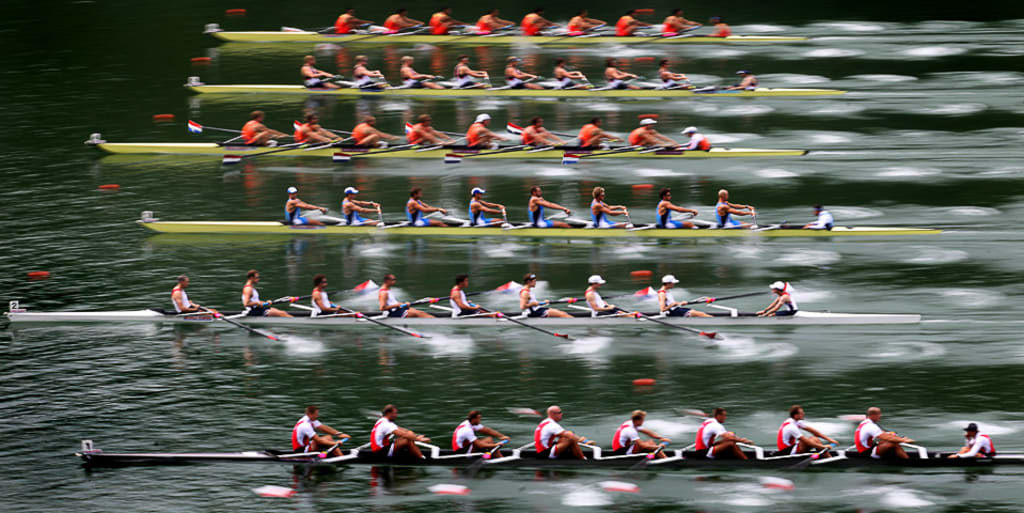
Sprint races, as in Olympic regattas, are the most straightforward form of racing between rowing crews. All the crews start together, race down a straight course, usually 2000 metres long, and the first to cross the finish line is the winner. The rules for such races are therefore not particularly complicated.
The crews must meet the stipulations for the race, such as the oarsmen or oarswomen being qualified for the particular class of race. For example, lightweight classes are reserved for rowers who weigh no more than 72.5kg for men or 59kg for women. There may also be restrictions as to who may compete in races organized under the aegis of a particular authority.
It is important that all the boats be correctly aligned at the start of the race. This is not always easy to arrange, especially if the course is on a river and the water is therefore moving under the boats. It is up to the cox of each boat to ensure that his boat is straight, and to signal to the starter when his crew is ready to row. In coxless races, this is the responsibility of the crew.
At Olympic and similar regattas, the boats are held at the stern by an electrically-operated gate, which releases the boat when the starter drops a flag or the light goes green. However, the common arrangement at other events is for the boat to be held by a person who is either lying at full length on a landing stage or is leaning over the side of a stake boat. They must release the boat at the instant of the start, and failure to do so could result in a false start.

The starter must check with the race judge and the timer that they are ready, then give the command “Attention” before pausing and given the command “Go” while dropping a red flag. If there is a “traffic light” system in force, the starter turns on a red light at “Attention” and changes the light to green at “Go”. If he has cause to abort the start after “Attention” he will say “As you were” and wait until conditions are suitable for starting before trying again.
If a crew crosses the start line before the “Go” command, a false start will be declared. A crew that causes two false starts will be disqualified from the race. If a boat fails to start, the race will go on without it, but the judge can order a restart if he thinks that there is good cause for so doing, for example if a starting gate has failed to release a boat.
During the course of the race, all the boats must stay within their racing lanes, assuming that this is taking place on a marked course. A crew can be warned and then disqualified for straying out of its lane or for interfering with a boat on an adjoining lane. On a river course, such as the Oxford and Cambridge Boat Race, coxes must steer in such as way as not to interfere with the other boat, and may not cross in front of the other boat (“taking the water”) until it is clear of it.
Crews may not be coached from the bank, or via a radio link, during a race.
The finish line is deemed to have been reached when the bow of the boat touches it. Assuming that no protests are received, the winning boat is the first to do so. There is a rule to the effect that the boat must contain the same number of rowers at the finish as at the start. It is not often that this rule is breached!
The procedure for Olympic and similar regattas is complicated by the “repechage” system. There are generally six competing boats in a sprint heat, of which only one or two are guaranteed to go through to the next round. All the other boats get a second chance when they compete against losing boats from other heats in repechage races (the word is French, and it literally means “to re-fish”, or to make a catch at the second attempt).
Lane order in successive rounds of a competition is decided by the order in which boats finish, and their times, in preceding rounds. Lanes 3 and 4 are generally awarded to the faster boats.
Rowing for 2000 metres at race pace requires a great deal of physical effort, especially if the water conditions are choppy. It has been estimated that the effort is equivalent to playing two basketball matches back-to-back. Sprint racing often produces very close and exciting results. It is not unknown for dead heats to occur.

About the Creator
John Welford
I am a retired librarian, having spent most of my career in academic and industrial libraries.
I write on a number of subjects and also write stories as a member of the "Hinckley Scribblers".






Comments
There are no comments for this story
Be the first to respond and start the conversation.